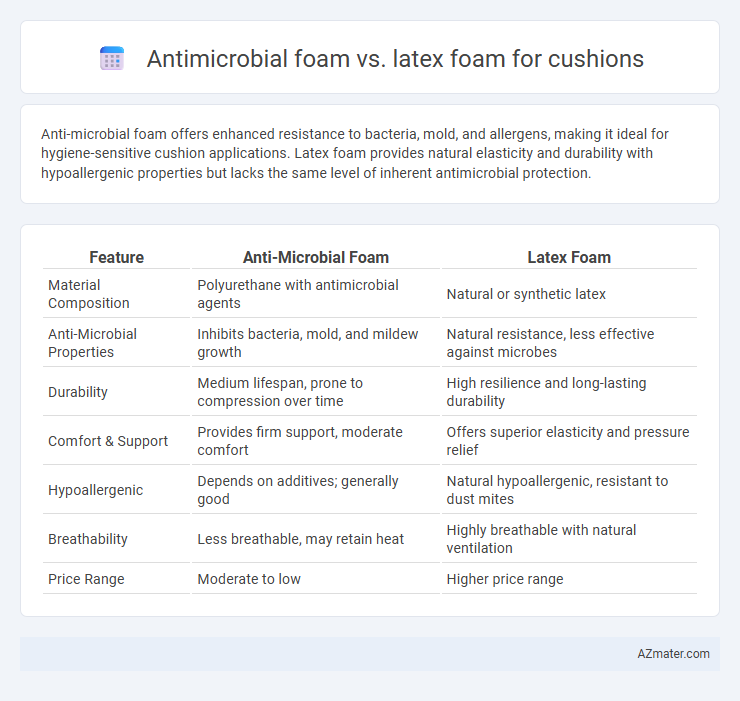Anti-microbial foam offers enhanced resistance to bacteria, mold, and allergens, making it ideal for hygiene-sensitive cushion applications. Latex foam provides natural elasticity and durability with hypoallergenic properties but lacks the same level of inherent antimicrobial protection.
Table of Comparison
| Feature | Anti-Microbial Foam | Latex Foam |
|---|---|---|
| Material Composition | Polyurethane with antimicrobial agents | Natural or synthetic latex |
| Anti-Microbial Properties | Inhibits bacteria, mold, and mildew growth | Natural resistance, less effective against microbes |
| Durability | Medium lifespan, prone to compression over time | High resilience and long-lasting durability |
| Comfort & Support | Provides firm support, moderate comfort | Offers superior elasticity and pressure relief |
| Hypoallergenic | Depends on additives; generally good | Natural hypoallergenic, resistant to dust mites |
| Breathability | Less breathable, may retain heat | Highly breathable with natural ventilation |
| Price Range | Moderate to low | Higher price range |
Introduction to Cushion Foam Materials
Anti-microbial foam offers enhanced resistance to bacteria, mold, and odors, making it ideal for hygienic cushion applications, while latex foam provides superior elasticity, durability, and natural hypoallergenic properties. Cushion foam materials vary in density and resilience, affecting comfort and longevity, with anti-microbial foams often incorporating specialized treatments or additives for improved cleanliness. Latex foam, derived from natural or synthetic sources, combines breathability with cushioning support, frequently preferred in sustainable or allergy-sensitive environments.
What is Anti-Microbial Foam?
Anti-microbial foam is a specially treated cushion material designed to resist the growth of bacteria, mold, and mildew, enhancing hygiene and durability. Unlike traditional latex foam, which naturally offers some antimicrobial properties due to its organic nature, anti-microbial foam undergoes chemical or physical treatment to actively prevent microbial contamination. This makes anti-microbial foam ideal for environments requiring enhanced sanitation, such as medical facilities and public seating.
Latex Foam: Composition and Properties
Latex foam, derived from natural rubber tree sap or synthetic latex, offers superior elasticity, durability, and breathability compared to anti-microbial foam. Its open-cell structure promotes excellent air circulation, reducing heat retention and moisture buildup, which enhances comfort and longevity. The inherent hypoallergenic and antimicrobial properties of natural latex contribute to its resistance against dust mites, mold, and bacteria, making it a preferable choice for cushion applications focused on hygiene and support.
Anti-Microbial Benefits in Cushioning
Anti-microbial foam in cushioning offers superior resistance to bacteria, mold, and allergens compared to traditional latex foam, enhancing hygiene and reducing odors in prolonged use. This foam's built-in antimicrobial agents actively inhibit microbial growth, making it ideal for environments requiring stringent sanitation such as hospitals or homes with allergies. Latex foam, while naturally resistant to dust mites, lacks the same broad-spectrum antimicrobial properties, resulting in less comprehensive protection against pathogens in cushions.
Comfort and Support Comparison
Anti-microbial foam cushions provide superior hygiene by preventing bacterial and fungal growth, enhancing comfort for sensitive skin and allergy sufferers, while offering consistent support through high-density resilience. Latex foam cushions deliver exceptional pressure relief and natural elasticity, promoting optimal spinal alignment and breathability but may lack inherent antimicrobial properties unless treated. Both foams excel in comfort, with anti-microbial foam prioritizing cleanliness and latex foam focusing on durable, eco-friendly support and airflow.
Durability and Lifespan Analysis
Anti-microbial foam offers enhanced resistance to bacterial growth and mold, significantly extending cushion durability compared to traditional latex foam. Latex foam provides natural resilience and elasticity, but its lifespan can be compromised by moisture and microbial accumulation. Durability analysis shows anti-microbial foam cushions maintain structural integrity and comfort over a longer period, especially in humid or high-use environments.
Allergen and Sensitivity Considerations
Anti-microbial foam cushions offer enhanced protection against bacteria, mold, and dust mites, significantly reducing allergen exposure for sensitive individuals compared to traditional latex foam. Latex foam can trigger allergic reactions in people with latex sensitivity or latex allergies, making it less suitable for those prone to skin irritation or respiratory issues. Choosing anti-microbial foam cushions can improve indoor air quality and provide a hypoallergenic environment, especially beneficial for allergy sufferers or patients with compromised immune systems.
Environmental Impact and Sustainability
Anti-microbial foam often contains chemical additives that can hinder biodegradability and complicate recycling processes, posing challenges for environmental sustainability. Latex foam, especially natural latex derived from rubber trees, is biodegradable, renewable, and generally has a lower carbon footprint, making it a more eco-friendly choice for cushions. The cultivation of rubber trees for natural latex also supports sustainable forestry practices and carbon sequestration.
Cost and Availability Factors
Anti-microbial foam for cushions typically costs more than latex foam due to specialized treatments that inhibit bacterial growth and enhance hygiene. Latex foam is widely available in various markets and tends to have a more stable pricing structure, benefiting from established manufacturing processes and natural rubber sources. Budget-conscious consumers often choose latex foam for cost-effectiveness, whereas anti-microbial foam appeals to health-focused buyers despite its higher price and limited availability.
Which Cushion Foam is Best for You?
Anti-microbial foam cushions provide superior resistance to bacteria, mold, and allergens, making them ideal for individuals with allergies or respiratory sensitivities, while latex foam offers natural breathability, durability, and pressure relief, benefiting those seeking eco-friendly and supportive cushioning. Choosing the best foam depends on your priority: anti-microbial protection for hygiene or latex's natural comfort and responsiveness. Consider usage environments, budget, and specific health needs to determine which foam aligns with your lifestyle and comfort requirements.

Infographic: Anti-microbial foam vs Latex foam for Cushion
 azmater.com
azmater.com